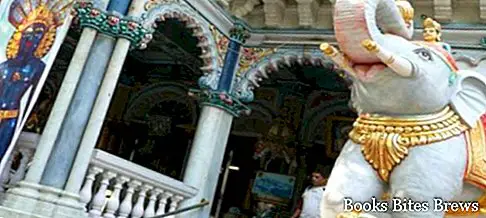What to see in Mumbai, itinerary including the main monuments and places of interest of ancient Bombay, including the railway station, St. Thomas Cathedral and Haji Ali Shrine.
Tourist information
Perched on a small island connected by bridges to the mainland, Mumbai is the largest city in India, as well as the country's main financial center and home to great wealth, with sparkling skyscrapers and trendy clubs, although a large part of the population lives in conditions of extreme poverty.
In Mumbai, the busy streets are traced with colonial architecture, there are also numerous temples and mosques.
It is possible to immerse yourself in colonial history at Chhatrapati Shivaji Terminus, at the Gateway of India and in the nearby legendary Taj Mahal Hotel.
Alternatively, you can head to Marine Drive, where there are a large number of art deco buildings.
Those who like modern life just go to Dhobi Ghat, where you can dance until dawn, after eating and drinking in the elegant clubs, or savor the arrival of dawn by the sea, sitting on the sand intent on tasting some local snack.
What see
Chhatrapati Shivaji Maharaj Vastu Sangrahalaya is the largest museum in Mumbai, housed in a large domed building, set amidst beautiful gardens.
Inside there is a collection of sculptures and miniature paintings, depicting weapons and stuffed animals.
Chhatrapati Shivaji Terminus is the central train station, building completed in 1888 for the Great Indian Peninsular Railway.
Designed by architect Stevens, it is one of the largest railway stations in the world, a wonderful mix of Victorian Gothic, Hindu and Islamic styles, with domes, turrets, spiers, stained glass windows and a magnificent staircase.
Horniman Circle, originally called Elphinstone Circle and epicenter of the Fort area, is made up of James Scott's elegant curves, terraces and arcades, with a garden in the center.
Recommended readings- India: useful information
- Mumbai (India): what to see in old Bombay
- Bangalore (India): what to see in the capital of Karnataka
- New Delhi (India): what to see in the capital
- Calcutta (India): what to see in the city of Mother Teresa
It was the first significant piece of redevelopment of the city, which began under the governorship of Sir Bartle Frere in 1860.
The central gardens are open to the public and offer a lush and shady retreat from the cacophony of the streets.
After independence, the club was renamed Horniman Circle, as the director of the Bombay Chronicle, Benjamin Horniman, was a staunch supporter of Indian independence.
Marine Drive is Mumbai's most famous thoroughfare, flanked by grandiose Victorian buildings, which descends from Malabar Hill to Nariman Point.
At night it shines with lampposts that, when viewed from above, look like a string of pearls, hence the nickname of the promenade Regina Necklace.
Chowpatty Beach, the only strip of sand in central Bombay, is a favorite destination for evening walks among the locals.
With a distinct neoclassical structure, overlooking Horniman Circle, the Town Hall building was built between 1821 and 1833, on a project by Colonel Thomas Cowper.
It originally stood on green Bombay, which was the center of the Fort area, one of the few remains of pre-Victorian Bombay.
It is an imposing structure ordered by colonnades, wrought iron stairs and parquet floors.
Today the building is used as a public library and houses more than 100,000 books, of which 15,000 are classified as rare and precious.
The Babulnath Temple is perched on the northeastern border of Malabar Hill, overlooking Chowpatty Beach, to get there you need to overcome a steep climb.
Located approximately 305 meters above sea level, the ancient temple of Lord Babulnath features elaborate sculptures and a large terrace.
Devotees rise to the top to receive temple deity darshan and blessings.
Nearby is the Walkeshwar junction and Marine Drive.
Stretching out to sea from the northern part of Marine Drive, Malabar Hill offers beautiful views of Bombay.
The hill is one of Bombay's most exclusive residential areas, where the state governor resides.
The area is also home to Banganga, an ancient water tank that is part of the Walkeshwar temple complex, and there are also some terraced roof gardens.
The Mumbadevi Temple, of Hindu origin, was built in honor of the patron of the city, the divinity Goddess Bombay, and is part of the rich history of Mumbai, inside there is the image of the Bombay Goddess, while a tiger, means of transport traditional of the Goddess, she sits in front of the sanctuary.
St. Thomas Cathedral, recently restored to its former glory, was the first Anglican church to be built in the city, it also constitutes the oldest English building in Mumbai.
Construction began in 1676, although the work was not completed until 1718.
The tower and clock were added in 1838 and the presbytery in 1863.
Very interesting are the colonial monuments that line the cathedral.
Worth noting is the monument belonging to Captain George Hardinge, who is carried away on a large shell pulled by two sea horses.
The University of Mumbai, one of the oldest universities in India, is housed in an imposing Gothic building designed by Gilbert Scott in 1857, the same architect responsible for London's Kings Cross station.
Jehangir Art Gallery, founded by Sir Cowasji Jehangir, constitutes the first exhibition space of contemporary art in Mumbai, equipped with four exhibition rooms where works by Indian artists are exhibited, mostly available for sale.
The Haji Ali Shrine was erected to commemorate a Muslim saint who died on the pilgrimage to Mecca.
This sacred building is located on a small island 500 meters from the coast, connected to the mainland via a narrow causeway, which allows access to the Sanctuary only during low tide periods.
The complex consists of a mosque and a tomb, both splendid examples of Indian Islamic architecture.




